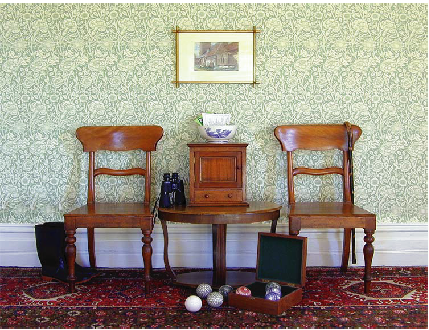William Morris Wallpapers
©2016 Stuart Stark Heritage Consultant
A History of Design Development
William Morris started designing wallpapers in the early 1860’s, at a period when most wallpapers were generally formal in design, in a repeating pattern.
Though naturally-inspired patterns have always been found in fabric and wallpaper design, William Morris introduced a new version of naturalistic patterns to wallpaper and fabric. Some of Morris’ designs were inspired – or copied – from historic designs he found in the Victoria and Albert Museum. But mostly, Morris designed from nature, using as a basis the plants and flowers found in his own gardens or in the woods and fields close to his homes.

Left: The more formal ‘diaper’ work (a name meaning patterns with an overall diamond pattern) wallpaper at left is typical of 1860’s wallpapers.
Right: William Morris’ “Fruit” (or ‘Pomegranate’) wallpaper from 1864, is more informal in design.
The individual wallpaper names speak to these naturalistic designs: Pink & Rose; Marigold; Rose; Wild Tulip; Daisy; Fruit; Michaelmas Daisy; and others. Other designs were named after nearby rivers: the Wandle; Medway, Evenlode and Cray – all with meandering, diagonal designs.

Left: “Pink & Rose” by William Morris was originally designed in 1890 as a single colour design, and later adapted in 1893 as a polychrome pattern. The flat pattern is a great contrast to other 1890’s wallpaper designs.
Right: A more typical 1890’s wallpaper design, with shaded roses, attempting a natural representation in a formal pattern.

‘Pink & Rose’ wallpaper designed by William Morris in Cream and Soft green. This design was originally produced in a tone on tone design. Later, Morris adapted it to a multi-colour pattern.
Morris primarily had his wallpapers printed by hand, using carved pear-wood blocks. Jeffrey & Co. was the printer for many of Morris & Co.’s wallpapers, and they continued printing Morris papers until 1940, when Morris’ firm went into liquidation.

Advertisement for Jeffrey & Co. showing printers hand-blocking wallpaper. The heavy wood blocks were counter balanced to allow easy positioning onto the wallpaper

A surface print machine for wallpaper.
Though Morris primarily had his wallpapers hand-printed using pear-wood blocks, he occasionally used a surface print machine. Today, almost all Morris-designed wallpapers are printed using these machines, which came into popularity c1884, and are not widely used today. Surface print machines give an unparalleled texture and finish to historic wallpapers.
The main distinction of Morris’ designs was the flat, stylized nature of his patterns. Other wallpaper and fabric of the Victorian period would have tried to imitate the full-blown roundness of a rose for example, with careful shading and colouring. Morris dispensed with all that, and drew patterns that were more like Japanese wood-block designs, with a certain formality in structure, but with an informal subject matter and overall design. Morris’ designs were also carefully worked out to make a visually pleasing repeats when covering a wall.






